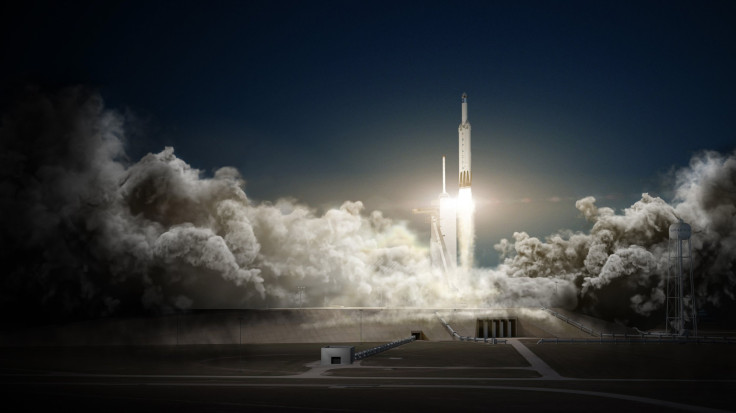Elon Musk Says SpaceX Falcon Heavy Rocket’s Test Flight In November

The most powerful present-day rocket in the world which also has the largest payload capacity is SpaceX’s Falcon Heavy, except one drawback — it has never even been fully tested, let alone flown. But company CEO Elon Musk announced late Thursday that SpaceX will finally test the Falcon Heavy in November, the clearest indication yet of the rocket’s “maiden launch.”
Musk made the announcement on his Instagram and Twitter accounts.
Falcon Heavy maiden launch this November https://t.co/D4Dxq9d6hc
— Elon Musk (@elonmusk) July 28, 2017
Even though the exact date for the test launch is not yet known, it will take place from NASA’s Kennedy Space Center in Florida, since SpaceX does not have the facilities at its development site in Texas to support the thrust produced by the Falcon Heavy. With the power of almost three Falcon 9 rockets (27 Merlin engines, compared to nine in the Falcon 9), the Falcon Heavy is expected to generate 5.1 million pounds of thrust at take-off.
Read: Blue Origin Vs. SpaceX: Jeff Bezos' New Glenn Rocket Bigger Than Falcon Heavy?
The 27 engines actually come from three cores in the rocket’s first stage, each of which is a Falcon 9 rocket, one of them as the center booster and the other two as side boosters. After lift-off, the center core engines throttle down, and the side cores power the rocket till the end of the first stage, when the two boosters separate and the center core powers up to full thrust again.
In another tweet Thursday, Musk said the two side boosters will return to the Cape Canaveral facility in Florida, while the central booster will land on a droneship. SpaceX has demonstrated successfully a few times both types of landings that allow it to reuse its rockets.
Side booster rockets return to Cape Canaveral. Center lands on droneship.
— Elon Musk (@elonmusk) July 28, 2017
The only rocket which had a larger payload capacity than the Falcon Heavy’s 54 metric tons (119,000 pounds) was the Saturn V moon rocket, which last flew in 1973. SpaceX claims the Falcon Heavy can carry twice the payload than the largest capacity rocket in operation, the Delta IV Heavy manufactured by United Launch Alliance (a joint venture of Lockheed Martin and Boeing). This high capacity for payload makes the rocket suited for crewed missions to the moon or even Mars.
However, getting the Falcon Heavy into orbit is no easy task. While the Falcon 9 has achieved that feat a number of times already, putting three of the lighter rocket’s engine cores together in one enormous machine is not just a simple matter of addition, as Musk explained at the International Space Station Research and Development Conference in Washington, D.C., on July 19.
“At first it sounds real easy, you just stick two first stages on as strap-on boosters, but then everything changes. All the loads change, aerodynamics totally change. You’ve tripled the vibration and acoustics. You sort of break the qualification levels on so much of the hardware. … The amount of load you’re putting through that center core is crazy because you’ve got two super-powerful boosters also shoving that center core, so we had to redesign the whole center core airframe. It’s not like the Falcon 9 because it’s got to take so much load. Then you’ve got separation systems,” Musk reportedly said.
Read: SpaceX Signs First Customer For Reused Falcon 9 Rocket
And despite knowing all that, and preparing accordingly, Musk wasn’t sure if the heavy rocket will actually be successful in its first launch test.
“There’s a lot of risk associated with Falcon Heavy, a real good chance that that vehicle does not make it to orbit. I want to make sure to set expectations accordingly. I hope it makes it far enough beyond the pad so that it does not cause pad damage. I would consider even that a win, to be honest,” Musk said of the November test.
If everything goes without a hitch, SpaceX has two more Falcon Heavy flights scheduled in the first half of 2018. If the rocket starts commercial flights by the end of 2018, as SpaceX plans, it could mean a big boost for the company, which is now already one of the world’s most valued privately held businesses. According to pricing made available by SpaceX, it will charge $90 million for carrying up to 8 metric tons of payload to geosynchronous transfer orbit. Data gathered by CNBC showed SpaceX is now valued at $21 billion, with only six other companies worldwide that are privately held and valued at over $20 billion.
© Copyright IBTimes 2024. All rights reserved.





















